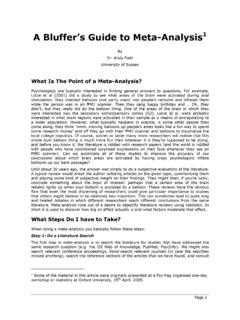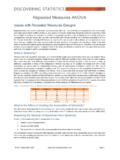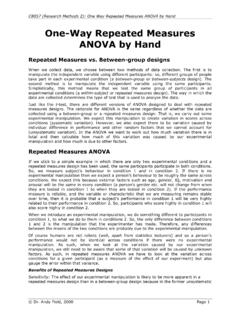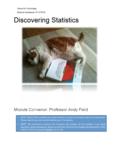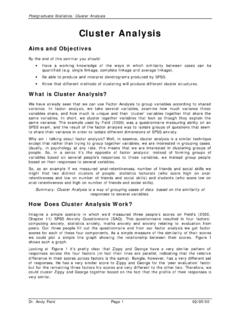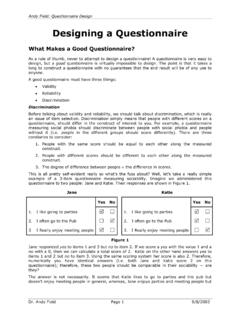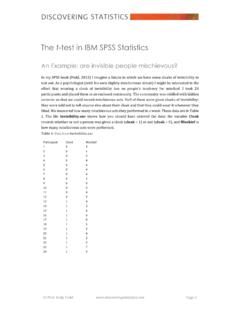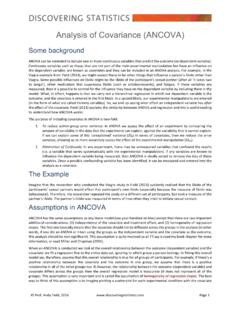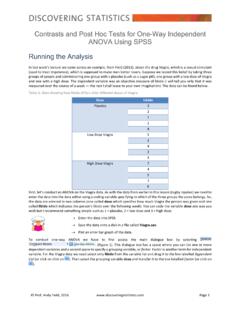Transcription of A Bluffer’s Guide to Sphericity - Discovering Statistics
1 A Bluffer's Guide to .. Sphericity Andy Field University of Sussex The use of repeated measures, where the same subjects are tested under a number of conditions, has numerous practical and statistical benefits. For one thing it reduces the error variance caused by between-group individual differences, however, this reduction of error comes at a price because repeated measures designs potentially introduce covariation between experimental conditions (this is because the same people are used in each condition and so there is likely to be some consistency in their behaviour across conditions).
2 In between-group ANOVA we have to assume that the groups we test are independent for the test to be accurate (Scariano & Davenport, 1987, have documented some of the consequences of violating this assumption). As such, the relationship between treatments in a repeated measures design creates problems with the accuracy of the test statistic. The purpose of this article is to explain, as simply as possible, the issues that arise in analysing repeated measures data with ANOVA: specifically, what is Sphericity and why is it important?
3 What is Sphericity ? Most of us are taught during our degrees that it is crucial to have homogeneity of variance between conditions when analysing data from different subjects, but often we are left to assume that this problem goes away' in repeated measures designs. This is not so, and the assumption of Sphericity can be likened to the assumption of homogeneity of variance in between-group ANOVA. Sphericity (denoted by and sometimes referred to as circularity) is a more general condition of compound symmetry. Imagine you had a population covariance matrix , where: BPS-MSC newsletter 6 (1) Page 13.
4 S112 12 13 .. 1n .. 21 s 22 23 .. 2 n . 2. = 31 32 s 33. 2.. 3n .. 2 . n1 n 2 n 3 .. s nn . Equation 1. This matrix represents two things: (1) the off-diagonal elements represent the covariances between the treatments 1 .. n (you can think of this as the unstandardised correlation between each of the repeated measures conditions); and (2) the diagonal elements signify the variances within each treatment. As such, the assumption of homogeneity of variance between treatments will hold when: s112 s 22. 2. s332 .. s nn 2. Equation 2.
5 ( when the diagonal components of the matrix are approximately equal). This is comparable to the situation we would expect in a between-group design. However, in repeated measures designs there is the added complication that the experimental conditions covary with each other. The end result is that we have to consider the effect of these covariances when we analyse the data, and specifically we need to assume that all of the covariances are approximately equal ( all of the conditions are related to each other to the same degree and so the effect of participating in one treatment level after another is also equal).
6 Compound Symmetry holds when there is a pattern of constant variances along the diagonal ( homogeneity of variance see Equation 2) and constant covariances off of the diagonal ( the covariances between treatments are equal see Equation 3). While compound symmetry has been shown to be a sufficient condition for conduction ANOVA on repeated measures data, it is not a necessary condition. 12 13 23 .. 1n 2 n 3 n .. Equation 3. Sphericity is a less restrictive form of compound symmetry (in fact much of the early research into repeated measures ANOVA confused compound symmetry with Sphericity ).
7 Sphericity BPS-MSC newsletter 6 (1) Page 14. refers to the equality of variances of the differences between treatment levels. Whereas compound symmetry concerns the covariation between treatments, Sphericity is related to the variance of the differences between treatments. So, if you were to take each pair of treatment levels, and calculate the differences between each pair of scores, then it is necessary that these differences have equal variances. Imagine a situation where there are 4 levels of a repeated measures treatment (A, B, C, D).
8 For Sphericity to hold, one condition must be satisfied: s A2 B s A2 C s A2 D s B2 C s B2 D sC2 D. Equation 4. Sphericity is violated when the condition in Equation 4 is not met ( the differences between pairs of conditions have unequal variances). How is Sphericity Measured? The simplest way to see whether or not the assumption of Sphericity has been met is to calculate the differences between pairs of scores in all combinations of the treatment levels. Once this has been done, you can simply calculate the variance of these differences.
9 Table 1 shows data from an experiment with 3 conditions (for simplicity there are only 5 scores per condition). The differences between pairs of conditions can then be calculated for each subject. The variance for each set of differences can then be calculated. We saw above that Sphericity is met when these variances are roughly equal. For this data, Sphericity will hold when: s A2 B s A2 C s B2 C. Where: s A2 B = s A2 C = s B2 C = As such, s A2 B s 2A C = s B2 C. BPS-MSC newsletter 6 (1) Page 15. Condition A Condition B Condition C A-B A-C B-C.
10 10 12 8 -2 2 5. 15 15 12 0 3 3. 25 30 20 -5 5 10. 35 30 28 5 7 2. 30 27 20 3 10 7. Variance: Table 1: Hypothetical data to illustrate the calculation of the variance of the differences between conditions. So there is, at least some deviation from Sphericity because the variance of the differences between conditions A and B is greater than the variance of the differences between conditions A. and C, and between B and C. However, we can say that this data has local circularity (or local Sphericity ) because two of the variances are identical ().
